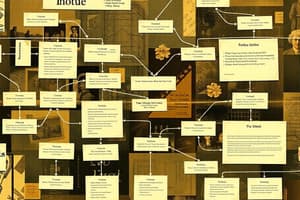Podcast
Questions and Answers
What is the first step in the problem-solving process?
What is the first step in the problem-solving process?
- Compiling, debugging and testing the program
- Defining the problem (correct)
- Writing the program
- Maintaining the program
Which principle allows breaking down a problem into smaller, manageable steps?
Which principle allows breaking down a problem into smaller, manageable steps?
- Brainstorming
- Divide and conquer (correct)
- Trial and error
- Linear thinking
What is an algorithm in the context of problem-solving?
What is an algorithm in the context of problem-solving?
- An undefined method of problem-solving
- A well-defined procedure to solve a problem (correct)
- A programming language
- A set of random instructions
How does a flowchart assist programmers?
How does a flowchart assist programmers?
What is the final step in the problem-solving sequence?
What is the final step in the problem-solving sequence?
Which of the following steps is NOT part of the sequence for problem-solving?
Which of the following steps is NOT part of the sequence for problem-solving?
In what way is information crucial in the problem-solving process?
In what way is information crucial in the problem-solving process?
What role does debugging play in programming?
What role does debugging play in programming?
What is one of the primary purposes of proper program documentation?
What is one of the primary purposes of proper program documentation?
During which phase is flowchart and pseudocode produced as essential documentation?
During which phase is flowchart and pseudocode produced as essential documentation?
What should be included as part of the program documentation for testing?
What should be included as part of the program documentation for testing?
What is a primary advantage of using machine language?
What is a primary advantage of using machine language?
Which statement best describes a disadvantage of machine language?
Which statement best describes a disadvantage of machine language?
What is a critical action to take when users identify errors or bugs in a program?
What is a critical action to take when users identify errors or bugs in a program?
What characterizes the process of documentation in a system development?
What characterizes the process of documentation in a system development?
What must a programmer do after writing an assembly language program?
What must a programmer do after writing an assembly language program?
Why might assembly language be preferred over high-level languages?
Why might assembly language be preferred over high-level languages?
What is a significant documentation component that aids in understanding each processing step?
What is a significant documentation component that aids in understanding each processing step?
Which aspect of system development is highlighted as most important related to program functionality?
Which aspect of system development is highlighted as most important related to program functionality?
What is a key characteristic of machine language?
What is a key characteristic of machine language?
What is one consequence of the difficulty of programming in machine language?
What is one consequence of the difficulty of programming in machine language?
What can be a consequence of failing to fix bugs found by users promptly?
What can be a consequence of failing to fix bugs found by users promptly?
Which of the following is true about assembly language?
Which of the following is true about assembly language?
What is the main limitation of machine language with regard to different computer types?
What is the main limitation of machine language with regard to different computer types?
What is the primary function of a compiler in programming?
What is the primary function of a compiler in programming?
What is an object file primarily composed of?
What is an object file primarily composed of?
Which programming language is recognized as the first to use an interpreter?
Which programming language is recognized as the first to use an interpreter?
What significant advantage does an interpreter have over a compiler?
What significant advantage does an interpreter have over a compiler?
Which of the following languages does NOT typically use an interpreter?
Which of the following languages does NOT typically use an interpreter?
What purpose does relocation data serve in an object file?
What purpose does relocation data serve in an object file?
Which statement best describes conditional logic in programming?
Which statement best describes conditional logic in programming?
Which programming concept uses keywords like 'if-then-else' for decision making?
Which programming concept uses keywords like 'if-then-else' for decision making?
What is a class in object-oriented programming?
What is a class in object-oriented programming?
Which of the following is NOT a major component of object-oriented programming?
Which of the following is NOT a major component of object-oriented programming?
What does encapsulation refer to in object-oriented programming?
What does encapsulation refer to in object-oriented programming?
Which programming language is considered one of the earliest examples of object-oriented programming?
Which programming language is considered one of the earliest examples of object-oriented programming?
What is the purpose of abstraction in object-oriented programming?
What is the purpose of abstraction in object-oriented programming?
In object-oriented programming, an object can best be described as:
In object-oriented programming, an object can best be described as:
Which of the following best describes the term 'information hiding'?
Which of the following best describes the term 'information hiding'?
Which of the following programming languages is generally NOT associated with the object-oriented paradigm?
Which of the following programming languages is generally NOT associated with the object-oriented paradigm?
Flashcards are hidden until you start studying
Study Notes
Problem-Solving Process
- Problem-solving involves defining the problem, designing a solution, writing a program, compiling, debugging, testing, documenting, and maintaining the program.
- The divide and conquer principle helps break down problems into manageable steps, making them easier to solve.
Algorithm Definition
- An algorithm is a well-defined procedure or set of instructions aimed at solving a problem.
- The initial step in any algorithm is defining the problem by recognizing the need for pertinent information.
Flowchart Usage
- Flowcharts visually represent the sequence of steps in an algorithm, using recognizable symbols for clarity.
- They serve as a graphical tool for programmers to illustrate program operations.
Documentation Importance
- Documentation encompasses written descriptions and explanations of programs and is crucial for successful data processing applications.
- Proper documentation aids programmers and system analysts in modifying existing programs and procedures.
- The process of documentation is ongoing, starting from the initial request for system information.
Maintenance Significance
- Maintenance involves updates and modifications to programs based on system requirements.
- Quick resolution of detected issues, such as data not being saved correctly, is essential to prevent larger problems in business operations.
Machine Language
- Advantages: Runs very fast as no translation is needed for execution by the CPU.
- Disadvantages: Difficult to program; requires detailed knowledge of hardware. Programs must be rewritten for different computer types and are hard to debug.
Low-Level Language Execution
- Low-level languages, such as assembly language, provide fine control over hardware operations but can be tricky to debug and maintain.
- They generally offer faster execution than high-level languages.
Interpreters vs. Compilers
- An interpreter translates high-level language code into machine code at runtime, offering immediate execution and avoiding lengthy compilation processes.
- Examples of interpreted languages include LISP, BASIC, Java, and Python.
Object-Oriented Programming (OOP)
- OOP focuses on creating software as a network of interacting objects, emphasizing modular design.
- Key Concepts:
- Objects: Instances of classes with defined boundaries and characteristics.
- Classes: Blueprints for creating objects, detailing behaviors, and attributes.
OOP Principles
- Abstraction: Allows viewing problems at varying detail levels based on context.
- Encapsulation: Hides internal details of objects from external interaction, promoting better organization.
Popular OOP Languages
- Well-known object-oriented programming languages include Java, C++, C#, Ruby, and Python.
Studying That Suits You
Use AI to generate personalized quizzes and flashcards to suit your learning preferences.



